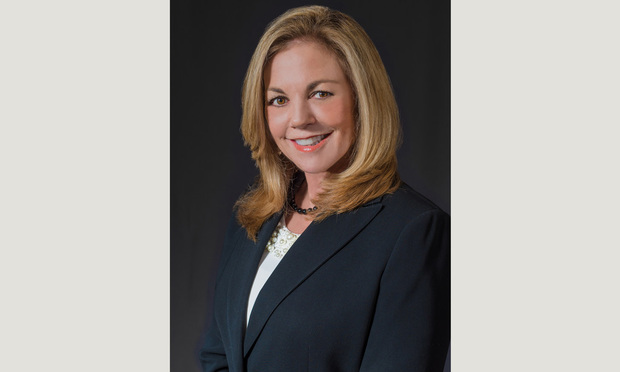Crane Operations: Legal Compliance and Risk Management
In the South Florida geographical location where it is exposed to the onslaught of hurricanes and other weather events, the presence of cranes and other hoisting equipment can pose serious concerns of job site and public safety.
November 07, 2019 at 10:02 AM
5 minute read
 Melinda S. Gentile of Peckar & Abramson.
Melinda S. Gentile of Peckar & Abramson.
Cranes are the quintessential "moving part" to construction sites. Look around any South Florida sky and you are likely to see cranes flying. This is a positive indication of ongoing construction and development. However, the use of cranes and other heavy hoisting equipment has resulted in several tragic accidents and fatalities. Especially in the South Florida geographical location where it is exposed to the onslaught of hurricanes and other weather events, the presence of cranes and other hoisting equipment can pose serious concerns of job site and public safety.
Those working on construction sites must abide by the Occupational Safety & Health Administration (OSHA) regulations and standards when operating cranes and hoisting equipment, see Section 29 C.F.R. 1926.550(a)(1)-(19). The OSHA regulations seek to ensure occupational safety by requiring compliance with either the manufacturer's specifications for erection, maintenance and operation of cranes and hoists or, if those are unavailable, compliance with the determinations of a qualified engineer. The OSHA regulations also require contractors to "designate a competent person who shall inspect all machinery and equipment prior to each use, and during use, to make sure it is in safe operating condition."
In 2012, the Florida legislature created Florida Statute 489.113(11) to prohibit any local act, law, ordinance or regulation, including, but not limited to, a local building code or building permit requirement, that is not already preempted by OSHA related to cranes and hoisting equipment. The statute includes worksite regulations regarding hurricane preparedness and public safety following OSHA's standards for crane safety.
Notwithstanding, there have been local government efforts to regulate crane operations. In 2008, Miami-Dade County enacted Ordinance No. 8-34, called the crane safety ordinance, mandating safety regulations for crane installation, operation and inspection, including hurricane preparedness. Following enactment, several construction and crane industry associations sued the county, challenging the ordinance. The U.S. Court of Appeals for the Eleventh Circuit ruled that because the ordinance contained nonapproved occupational safety and health regulations conflicting with a federal standard, the enforcement of the ordinance was preempted.
Many in the construction industry would argue that OSHA's requirements are not tailored to the type of safety requirements needed in Florida in preparation of hurricanes. Under OSHA Section 1926.1433 the European Standard is followed, which requires erected cranes to sustain winds roughly equivalent to a category one hurricane, far below the hurricane force winds all too often experienced in Florida. For example, in 2017, Hurricane Irma's 120 mph winds took down three cranes in Miami-Dade and Broward counties, causing damage to construction sites and high-rise buildings nearby.
In September 2019, Hurricane Dorian threatened Florida with its category five-level winds. As a result, the governor temporarily waived the preemption requirement under Section 489.113 and allowed county officials to direct crane hurricane preparedness. This temporary offset of power sheds light on the need for stricter and more localized crane regulations. Directly following Hurricane Dorian, Senate Bill 272 was proposed, which aims to create an exception to Section 489.113's preemption language and to authorize local worksite regulation regarding hurricane preparedness. The bill is in its early stages, but could lead to localizing hurricane preparedness protocol.
Crane accidents can result in significant damages and can include, among other things, death, personal injury, property damage and the productivity loss associated with work stoppage during damage remediation. These risks expand beyond the construction site and may impact surrounding areas. It is therefore essential to have construction site protections in place, as well as carefully drafted contractual provisions and the procurement of appropriate insurance coverage.
When drafting construction contracts, it is important that the contract language require crane companies to comply with all governing safety regulations and also indemnify the developer and general contractor, among others as appropriate, from damages resulting from their obligations. Florida Statute Section 725.06 provides limitations on the enforceability of contractual terms whereby one party indemnifies another party against liability for damages to persons or property caused by any act, omission or default of the indemnitee arising from the contract or its performance. Careful negotiation of such risk-shifting terms is crucial when crane operations are at issue.
Additionally, crane companies should be required to provide liability insurance with sufficient limits to cover the potential consequential damages resulting from a crane accident. In order to maximize the protections provided, developers and contractors, among others, should be named as additional insureds to allow them to look directly to the crane company's insurance carrier for covered losses. Moreover, insureds should obtain an executed endorsement, not just an insurance certificate, to ensure coverage.
In order to avoid crane accidents, it is necessary to conduct proper construction planning and comply with safety standards. Safety is the primary concern but proper planning in advance of crane operations can work to mitigate and appropriately shift the risk of the damage when an accident occurs.
—Jessica Shevlin, a law clerk with the firm, assisted in the preparation of this article.
Melinda S. Gentile is a Florida board certified construction law attorney in the Miami office of Peckar & Abramson. Contact her at [email protected].
This content has been archived. It is available through our partners, LexisNexis® and Bloomberg Law.
To view this content, please continue to their sites.
Not a Lexis Subscriber?
Subscribe Now
Not a Bloomberg Law Subscriber?
Subscribe Now
NOT FOR REPRINT
© 2025 ALM Global, LLC, All Rights Reserved. Request academic re-use from www.copyright.com. All other uses, submit a request to [email protected]. For more information visit Asset & Logo Licensing.
You Might Like
View All
Essential Labor Shifts: Navigating Noncompetes, Workplace Politics and the AI Revolution

Initial Steps to Set Up a Fla. Appeal: Your Future Self (or Appellate Attorney) Will Thank You
6 minute read
Divorce Timing Is Everything: Waiting for the New Year May Have Its Advantages
4 minute read
Motions for Summary Judgment and Discovery: The 2021 Rule Changes Continue to Emerge
5 minute readTrending Stories
- 1'It's Not Going to Be Pretty': PayPal, Capital One Face Novel Class Actions Over 'Poaching' Commissions Owed Influencers
- 211th Circuit Rejects Trump's Emergency Request as DOJ Prepares to Release Special Counsel's Final Report
- 3Supreme Court Takes Up Challenge to ACA Task Force
- 4'Tragedy of Unspeakable Proportions:' Could Edison, DWP, Face Lawsuits Over LA Wildfires?
- 5Meta Pulls Plug on DEI Programs
Who Got The Work
Michael G. Bongiorno, Andrew Scott Dulberg and Elizabeth E. Driscoll from Wilmer Cutler Pickering Hale and Dorr have stepped in to represent Symbotic Inc., an A.I.-enabled technology platform that focuses on increasing supply chain efficiency, and other defendants in a pending shareholder derivative lawsuit. The case, filed Oct. 2 in Massachusetts District Court by the Brown Law Firm on behalf of Stephen Austen, accuses certain officers and directors of misleading investors in regard to Symbotic's potential for margin growth by failing to disclose that the company was not equipped to timely deploy its systems or manage expenses through project delays. The case, assigned to U.S. District Judge Nathaniel M. Gorton, is 1:24-cv-12522, Austen v. Cohen et al.
Who Got The Work
Edmund Polubinski and Marie Killmond of Davis Polk & Wardwell have entered appearances for data platform software development company MongoDB and other defendants in a pending shareholder derivative lawsuit. The action, filed Oct. 7 in New York Southern District Court by the Brown Law Firm, accuses the company's directors and/or officers of falsely expressing confidence in the company’s restructuring of its sales incentive plan and downplaying the severity of decreases in its upfront commitments. The case is 1:24-cv-07594, Roy v. Ittycheria et al.
Who Got The Work
Amy O. Bruchs and Kurt F. Ellison of Michael Best & Friedrich have entered appearances for Epic Systems Corp. in a pending employment discrimination lawsuit. The suit was filed Sept. 7 in Wisconsin Western District Court by Levine Eisberner LLC and Siri & Glimstad on behalf of a project manager who claims that he was wrongfully terminated after applying for a religious exemption to the defendant's COVID-19 vaccine mandate. The case, assigned to U.S. Magistrate Judge Anita Marie Boor, is 3:24-cv-00630, Secker, Nathan v. Epic Systems Corporation.
Who Got The Work
David X. Sullivan, Thomas J. Finn and Gregory A. Hall from McCarter & English have entered appearances for Sunrun Installation Services in a pending civil rights lawsuit. The complaint was filed Sept. 4 in Connecticut District Court by attorney Robert M. Berke on behalf of former employee George Edward Steins, who was arrested and charged with employing an unregistered home improvement salesperson. The complaint alleges that had Sunrun informed the Connecticut Department of Consumer Protection that the plaintiff's employment had ended in 2017 and that he no longer held Sunrun's home improvement contractor license, he would not have been hit with charges, which were dismissed in May 2024. The case, assigned to U.S. District Judge Jeffrey A. Meyer, is 3:24-cv-01423, Steins v. Sunrun, Inc. et al.
Who Got The Work
Greenberg Traurig shareholder Joshua L. Raskin has entered an appearance for boohoo.com UK Ltd. in a pending patent infringement lawsuit. The suit, filed Sept. 3 in Texas Eastern District Court by Rozier Hardt McDonough on behalf of Alto Dynamics, asserts five patents related to an online shopping platform. The case, assigned to U.S. District Judge Rodney Gilstrap, is 2:24-cv-00719, Alto Dynamics, LLC v. boohoo.com UK Limited.
Featured Firms
Law Offices of Gary Martin Hays & Associates, P.C.
(470) 294-1674
Law Offices of Mark E. Salomone
(857) 444-6468
Smith & Hassler
(713) 739-1250






